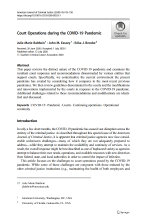By Brandon L. Garrett, JD, Monitor, et al.
The ODonnell Consent Decree
Misdemeanor Bail Reform: In Harris County, secured money bonds are no longer required for most misdemeanor cases under the court rule adopted as part of the ODonnell v. Harris County settlement. Most people arrested for misdemeanors are released promptly without a hearing.
Bail Options Unchanged for Cases with Public Safety Concerns: People charged with misdemeanors that potentially present public safety risks (e.g., repeat DWIs, family violence, prior bond violations or outstanding warrants) are not automatically released. A hearing officer makes a bail decision, usually following a hearing at which magistrates have the traditional options to require financial bonds, protective orders, pretrial supervision requirements, or other release conditions.
Better Bail Hearings: Defense attorneys continue to represent people at bail hearings, as required by Rule 9 and the Consent Decree. Before 2017, people arrested in Harris County usually had no defense attorney at these hearings. Judges also must give greater attention to more rigorous bail requirements.
Major Consent Decree Accomplishments:
Court Appearance: The County is currently implementing an approved plan to make use of the budget allocation to improve court appearance. The County is now piloting a new website, https://myharriscountycase.com, where people can readily look up information about upcoming appearances in their cases.
Data: Much of the relevant information about the misdemeanor bail process is now available in an automated report. We have continued work to provide feedback on Harris County’s public data portal. We now have improved data regarding persons flagged as homeless or with mental health assessment requests, as well as data concerning pretrial supervision conditions, and report these new analyses in this report.
Training: The Deason Criminal Justice Reform Center at the SMU Dedman School of Law conducted trainings in 2023, which resume in early 2024.
Indigent Defense: The County is continuing to develop plans in response to the National Association for Public Defense (NAPD) evaluation of Harris County’s misdemeanor indigent defense systems. We hope the County will implement a plan for the earlier appointment of counsel.
Ongoing Work by the Monitor Team:
Data Development: We analyzed data prepared by Harris County and provided continual feedback on data development in regular meetings concerning the assembly and validation of data regarding misdemeanor cases.
Community Work Group: We convened quarterly meetings of our Community Work Group, to share our work and solicit input from our diverse community stakeholders. Members share their perspectives for the “Community Viewpoints” column found in our reports.
Regular Meetings: We held regular meetings with the parties and Harris County stakeholders, including weekly calls, monthly meetings with both judges and hearing officers, and periodic calls with public defenders and prosecutors. Our next public meetings will be held in-person on April 18, 2024.
Feedback: We provided feedback to the parties on several improvements to the hearing process, the designed and implemented training, and the assessment work regarding holistic defense services and nonappearance. o Review of Violations: We are extremely grateful for the work that has begun to build an improved system to permit all County actors to review potential Rule 9 violations and prevent delays and errors in case processing.
Our Findings:
Data Analysis: Our updated findings largely confirm what we reported in our first six reports. The bail reforms under the ODonnell Consent Decree have saved Harris County and residents many millions of dollars, improved the lives of tens of thousands of persons arrested for misdemeanors, and these large-scale changes have produced no increase in new offenses by persons arrested for misdemeanors.
Overall, the work suggests that repeat offending by persons arrested for misdemeanors has remained stable in recent years.
The numbers of persons arrested for misdemeanors have declined since 2015.
The numbers of those arrested for misdemeanors who had new charges filed within one year have also declined.
The analyses conducted show:
Misdemeanor Case and Defendant Characteristics
The number of misdemeanor arrestees has declined by more than 15 percent between 2015 (N=49,359) and 2023 (N=41,177).
The count has been slightly increasing since 2020, which marked the beginning of the Covid-19 pandemic period.
Durham, NC: Duke University, 2024. 107p.



